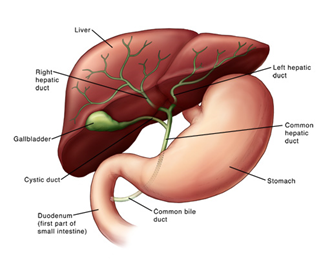Alagille Syndrome
What is alagille syndrome?
Alagille syndrome is an inherited condition in which bile builds up in the liver because there are too few bile ducts to drain the bile. This results in liver damage.
Your liver makes bile to help remove waste from your body. It also helps digest fats and the fat-soluble vitamins A, D, E, and K. The body can use these vitamins only if they are combined with fat from the foods you eat. Bile ducts are the channels that move bile out of your liver. If you do not have enough of these ducts, bile builds up in your liver. It damages your liver tissues, and ultimately can cause your liver to fail. As treatment options increase, people with this condition live longer, more comfortable lives, especially if the condition is discovered early. About 75% of people diagnosed with the syndrome in childhood live to at least age 20.
What causes alagille syndrome?
Alagille syndrome is related to the JAG1 gene mutation. It may be passed from parent to child. If you have one parent with Alagille syndrome, you have a 50% chance of developing the condition. It appears in one out of 70,000 babies and occurs in both sexes. However, about half the time, the mutation is new and not from a parent.
What are the symptoms of alagille syndrome?
Symptoms of Alagille syndrome usually appear in the first two years of life. The following are the most common symptoms of Alagille syndrome. However, each person may experience symptoms differently. Symptoms may include:
Yellow skin or eyes. Bile is colored with a pigment called bilirubin. Some of the changes you might see when your liver isn’t able to get rid of bile well enough are related to this pigment. If bile isn’t leaving your body properly, you may have yellowish skin and yellowing in the whites of your eyes, called jaundice. Your stool may appear pale, gray, or white because of a lack of bile. Your urine also can appear a darker color. A newborn may have jaundice for a few days or weeks until his or her liver works more effectively.
Itchy skin. Increased bilirubin in your body can cause an itching sensation, called pruritus.
Delayed growth. Alagille syndrome can make it hard for the body to use nutrients, such as fat-soluble vitamins. This can affect growth and normal development.
Hard skin bumps. Yellow growths called xanthomas are small amounts of fat that collect under the skin because of high cholesterol levels in your body.
Heart murmur. This is caused by narrower-than-normal blood vessels that take blood from the heart to the lungs.
Changes in blood vessels. The blood vessels in the head and neck may be formed abnormally. Other blood vessels can also become smaller or unusually shaped. These changes in blood vessels can lead to serious health problems such as stroke.
Facial characteristics. Children with this condition may have deep-set eyes; a prominent, wide forehead; a straight nose; and a pointed, small chin. These characteristics may not be visible until after infancy.
Spinal growth changes. Bones in the spine may appear different on X-rays but usually don’t cause any difficulties for patients and aren’t visible to the naked eye.
Kidney disease. Kidneys may be smaller, contain cysts, or simply work less efficiently.
Enlarged spleen. Because the liver isn’t able to rid itself of excess fluids effectively, blood may back up into the spleen. This can cause the spleen to swell. The spleen’s job is to help clean the blood and prevent infection. An enlarged spleen is more likely to be injured, especially in sports play.
White ring in the eye. A ring on the cornea, called a posterior embryotoxon, is a classic sign of the syndrome. The ring is visible during an eye exam.
The symptoms of Alagille syndrome may look like other medical conditions or problems. Always consult your healthcare provider for a diagnosis.
How is alagille syndrome diagnosed?
Your healthcare provider will perform an exam and obtain a medical history. Other tests may be done to evaluate whether you have Alagille syndrome may include:
Liver biopsy
Heart and blood vessel tests
Eye exams
Spine X-ray
Abdominal ultrasound
Kidney function tests
Genetic testing
A diagnosis of Alagille syndrome is confirmed by a liver biopsy that shows fewer bile ducts than normal and at least 3 of these symptoms:
Face shapes characteristic of Alagille syndrome
Unusual bone/spine structures such as a butterfly vertebrae
Unusual heart/blood vessel structures or a heart murmur
Liver problems
A characteristic white ring on the cornea
How is alagille syndrome treated?
Your healthcare provider will figure out the best treatment for you based on:
Your age
Your overall health and past health
How sick you are
How well you can handle specific medicines, procedures, or therapies
How long the condition is expected to last
Your opinion or preference
Specific treatments for Alagille syndrome may include:
Medicine to increase bile flow out of the liver
Medicine to relieve itching sensations
Skin care, such as moisturizers, to reduce itching
Vitamin supplements
High-calorie food supplements
Surgery to redirect bile so that less bilirubin ends up in your blood
Liver transplant in the case of liver failure
What are the complications of alagille syndrome?
Bleeding into the brain
Bone fractures
Death
Delayed mental or physical growth or failure to thrive
Diarrhea
Heart disease
Kidney failure
Liver failure, which happens in about 15% of those affected
Malnutrition
Pancreas disease
Problems with the eyes
Can alagille syndrome be prevented?
Genetic testing and a discussion of the inherited risks within your family may help you make informed decisions about preventing this disease in future generations.
Living with alagille syndrome
Alagille syndrome affects many organs and aspects of your life. Make sure you:
Work closely with your medical team to increase bile flow and treat symptoms, such as itching, related to bile backup.
Ask questions if you do not understand how to use medicines.
Follow instructions for diet or lifestyle changes to improve health and comfort.
When to call the doctor about alagille syndrome
Alagille syndrome has wide-ranging effects that may be different as the years go by and your treatment may need to be changed. Talk with your medical team to find out which signs and symptoms require immediate medical attention. In general, be aware of the symptoms listed above. Contact your healthcare provider if symptoms get worse despite treatment or if new symptoms appear.
Key points
Alagille syndrome is a genetic disorder in which you have fewer bile ducts than normal in your liver.
Alagille syndrome can be passed from parent to child or happen naturally.
Alagille syndrome not only affects the liver, it can also cause skin, heart, facial, kidney, and eye abnormalities.
Treatment for Alagille syndrome can prevent or minimize complications and improve quality of life.
Treatment needs to change over time, so it is important to work with your healthcare provider.
Genetic counseling can help you understand your family’s risk for Alagille syndrome.





